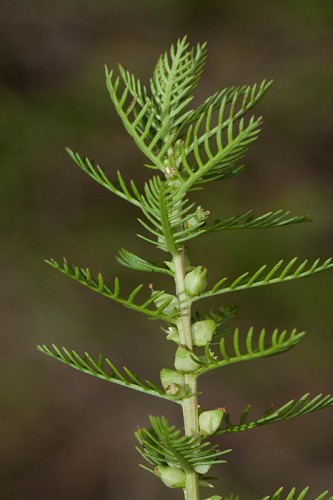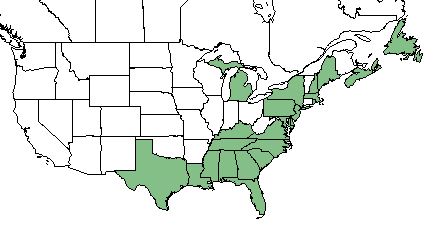Difference between revisions of "Proserpinaca pectinata"
(→Ecology) |
HaleighJoM (talk | contribs) (→Ecology) |
||
| (One intermediate revision by one other user not shown) | |||
| Line 40: | Line 40: | ||
<!--===Seed dispersal===--> | <!--===Seed dispersal===--> | ||
<!--===Seed bank and germination===--> | <!--===Seed bank and germination===--> | ||
| − | + | ||
| − | <!--===Pollination and | + | ===Fire ecology=== <!--Fire tolerance, fire dependence, adaptive fire responses--> |
| − | <!--==Diseases and parasites==--> | + | Populations of ''Proserpinaca pectinata'' have been known to persist through repeated annual burning.<ref>Platt, W.J., R. Carter, G. Nelson, W. Baker, S. Hermann, J. Kane, L. Anderson, M. Smith, K. Robertson. 2021. Unpublished species list of Wade Tract old-growth longleaf pine savanna, Thomasville, Georgia.</ref> |
| + | <!--===Pollination===--> | ||
| + | <!--===Herbivory and toxicology===<!--Common herbivores, granivory, insect hosting, poisonous chemicals, allelopathy, etc--> | ||
| + | <!--===Diseases and parasites===--> | ||
==Conservation, cultivation, and restoration== | ==Conservation, cultivation, and restoration== | ||
Latest revision as of 14:24, 15 July 2022
| Proserpinaca pectinata | |
|---|---|

| |
| Photo by John Gwaltney hosted at Southeastern Flora.com | |
| Scientific classification | |
| Kingdom: | Plantae |
| Division: | Magnoliophyta - Flowering plants |
| Class: | Magnoliopsida - Dicots |
| Order: | Haloragales |
| Family: | Haloragaceae |
| Genus: | Proserpinaca |
| Species: | P. pectinata |
| Binomial name | |
| Proserpinaca pectinata Lam. | |

| |
| Natural range of Proserpinaca pectinata from USDA NRCS Plants Database. | |
Common Names: feathery mermaid-weed;[1] combleaf mermaidweed[2]
Contents
Taxonomic Notes
Synonyms: none
Description
Proserpinaca pectinata is a dioecious perennial that grows as a forb/herb.[2] Flowers are red, orange, and green in color.[3]
Distribution
This species is disjunct in Nova Scotia and the Great Lakes region[4], south to southern Florida, and westward to western Louisiana. While it is primarily found along the coastal plain, it occurs inland, as far as Tennessee[1], and has disjunct populations in western Cuba.[5]
Ecology
Habitat
P. pectinata occurs in bogs, savannas, ditches, longleaf pine forests, wet pine flatwoods, and other wet places.[1][6] Along New York pond shorelines, this species is found on areas of organic exposed pond bottoms and permanently flooded zones.[7] It is also found in disturbed areas including powerline transects and borrow pits.[6] Associated species: Cyrilla parvifolia, Salix humilis, Cephalanthus occidentalis, Saccharum sp., Dichanthelium scoparium, Smilax rotundifolia, Proserpinaca pectinata, and Hypericum crux-andreae.[6]
In New Jersey pinelands, Proserpinaca pectinata occurred in 20% of ponds.[8]
Proserpinaca pectinata is an indicator species for the Calcareous Savannas community type as described in Carr et al. (2010).[9]
Phenology
In the southeastern and mid-Atlantic United States, flowering has been observed from June through October.[1][10]
Fire ecology
Populations of Proserpinaca pectinata have been known to persist through repeated annual burning.[11]
Conservation, cultivation, and restoration
Cultural use
Photo Gallery
References and notes
- ↑ 1.0 1.1 1.2 1.3 Weakley AS (2015) Flora of the Southern and Mid-Atlantic States. Chapel Hill, NC: University of North Carolina Herbarium.
- ↑ 2.0 2.1 USDA NRCS (2016) The PLANTS Database (http://plants.usda.gov, 31 January 2018). National Plant Data Team, Greensboro, NC 27401-4901 USA.
- ↑ Plant database: Proserpinaca pectinata. (31 January 2018) Lady Bird Johnson Wildflower Center. URL: https://www.wildflower.org/plants/result.php?id_plant=PRPE
- ↑ Sorrie, B. A. and A. S. Weakley 2001. Coastal Plain valcular plant endemics: Phytogeographic patterns. Castanea 66: 50-82.
- ↑ Sorrie, B. A. and A. S. Weakley 2001. Coastal Plain valcular plant endemics: Phytogeographic patterns. Castanea 66: 50-82.
- ↑ 6.0 6.1 6.2 Florida State University Herbarium Database. URL: http://herbarium.bio.fsu.edu. Last accessed: June 2021. Collectors: Robert K. Godfrey. States and counties: Florida: Leon and Wakulla. Georgia: Thomas.
- ↑ Zaremba RE, Lamont EE (1993) The status of the coastal plain pondshore community in New York. Bulletin of the Torrey Botanical Club 120(2):180-187.
- ↑ Laidig KJ (2012) Simulating the effect of groundwater withdrawals on intermittent-pond vegetation communities. Ecohydrology 5:841-852.
- ↑ Carr, S.C., K.M. Robertson, and R.K. Peet. 2010. A vegetation classification of fire-dependent pinelands of Florida. Castanea 75:153-189.
- ↑ Nelson, G. PanFlora: Plant data for the eastern United States with emphasis on the Southeastern Coastal Plains, Florida, and the Florida Panhandle. www.gilnelson.com/PanFlora/ Accessed: 31 JAN 2018
- ↑ Platt, W.J., R. Carter, G. Nelson, W. Baker, S. Hermann, J. Kane, L. Anderson, M. Smith, K. Robertson. 2021. Unpublished species list of Wade Tract old-growth longleaf pine savanna, Thomasville, Georgia.